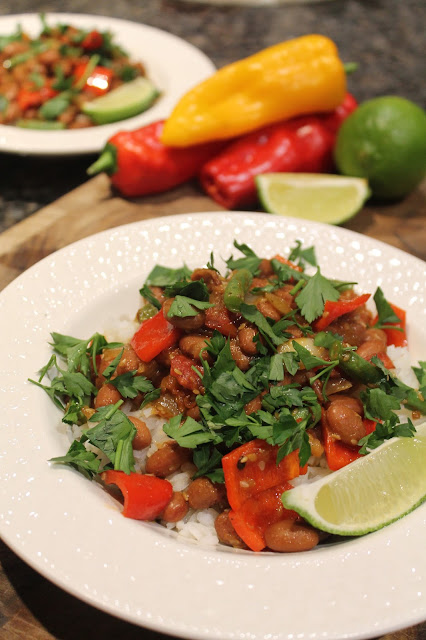Friday, 15 January 2016
South Indian Curry
It's a new year which for me, means trying new recipes and getting re-invigorated in the kitchen. Not to mention, January tends to bring out a desire to eat "better" or "cleaner". While I hate using terms like these (as it implies any other way of eating is "bad" or "dirty") I too find myself eating lighter and using more vegetables in January. Perhaps this is just the natural cycle of life - after eating a fair amount of rich foods in December, we want a change of pace in January. I'm in the mood for food which is full of brighness, freshness, and above all has a lot of flavour.
I really get a lot of pleasure from cooking different cuisines and foods from all over the globe. I especially love Indian cuisine and have tried my hand at cooking a lot of northern Indian or Punjabi style curries in the past (which I absolutely adore). However, I haven't really tried cooking much from the south of India and specifically vegetarian Indian cuisine.
I often come across South Indian curry recipes in magazines and in some of my cookbooks and often make a mental note to try these recipes. However, it wasn't until recently that I actually cooked a southern Indian curry and immediately fell in love. I took inspiration from recipes I've seen and created my own version of this style of cuisine. Subsequently, I was amazed at how complex and vibrant the flavours are without using any meat protein. I must be honest and say, often times when I make a vegetarian dish for myself (who's absolutely not a vegetarian) I end up adding some chicken stock to amp up the flavour. However, this recipe completely holds it's own without the addition of any stock. Making it a great option if cooking for a vegan or vegetarian. As well, this dish somehow balances being nourishing and yet very sustaining at the same time; this is not the type of food that will leave you needing a second dinner later on in the evening. It will leave you feeling pleasantly satisfied but not bloated and full.
I must say, I can't speak to how "authentic" this recipe is or if it would be considered a North Americanized knock off of true south Indian cuisine. However, I feel that it's okay to not always be perfectly authentic when cooking cuisines of other countries. Often times, it's difficult to find the necessary ingredients to puritanically re-create food we've experienced in restaurants or from other parts of the world. Not to mention, cooking in such a strictly confined way really kills the creativity and spontaneity of home cooking. The food police aren't knocking on doors to critique the ingredients we choose to use in the privacy of our own kitchens. Not to mention, it's my experience that when you go looking for the truest or most authentic recipe for a traditional dish (from any number of cuisines) you get a multitude of options and recipes. That is to say, everyone has their own way of cooking the food of their culture and recipes differ from family to family. It's my opinion that cooking in the most authentic way for any type of cuisine doesn't really exist as it varies from region to region and person to person. At the end of the day, I love to cook with the joy and pleasure of being inspired to try new things in my kitchen; not constricted of worries people will disapprove or judge.
Here's my recipe for South Indian Curry:
Vegetable or Canola Oil
1 medium onion chopped
1 clove of garlic minced
1 tablespoon of sesame seeds
1 tablespoon of curry powder (I used Madras, but any curry powder will do)
Cayenne Pepper to taste (I used 1/2 teaspoon, for hot)
3 Roma tomatoes roughly chopped
1/2 cup of water
1 red pepper roughly chopped
large handful of green beans chopped
1 398ml can of pinto beans
Salt and pepper to taste
Handful of cilantro
Zest and juice of a lime
Over medium heat, warm a large cast iron skillet or pan. Add about 1 tablespoon of vegetable or canola oil and then add the chopped onion and garlic and saute until the onions are slightly translucent. Then add the sesame seeds, curry powder and cayenne pepper allowing the mixture to continue cooking for a minute or so to toast both the seeds and the spice.
Now add the tomatoes, tossing then slightly with the onion mixture. Add the water and allow the tomatoes to cook down, brown well, and break apart while the liquid reduces to a nice thick tomato sauce.
Add the peppers, green beans and pinto beans (or any beans you like) and cook for about 2 minutes or until the beans and peppers are cooked to al dente and slightly softened and the green beans are still vibrantly green.
Season with salt and pepper to taste and add the juice and zest of half a lime to the mixture and serve with some basmati or jasmine rice with a large handful of roughly chopped cilantro scattered over top and lime wedges alongside.
Subscribe to:
Post Comments (Atom)










No comments:
Post a Comment
Thanks for taking the time to comment! I look forward to reading your thoughts and feedback. Take care.